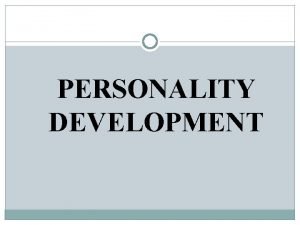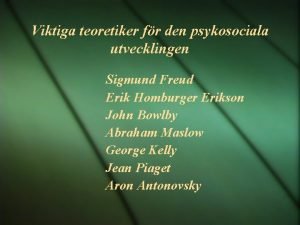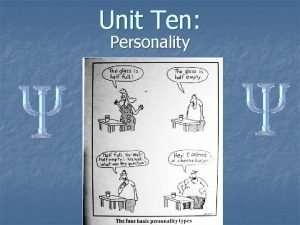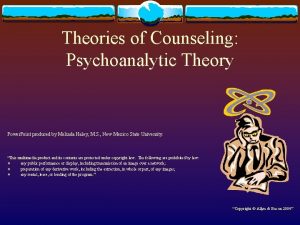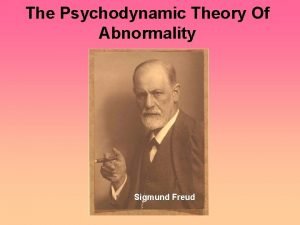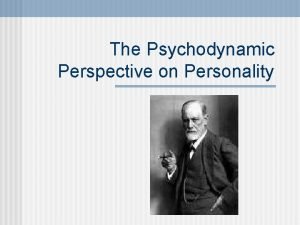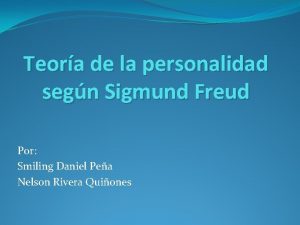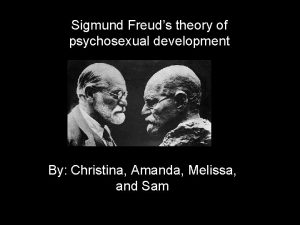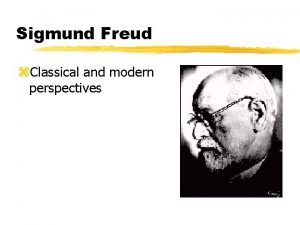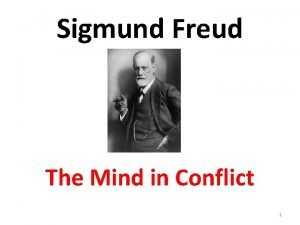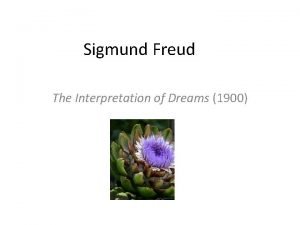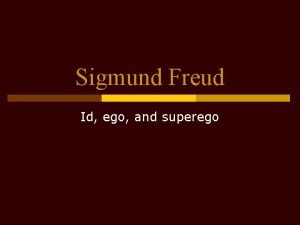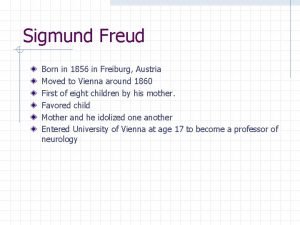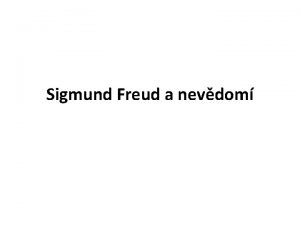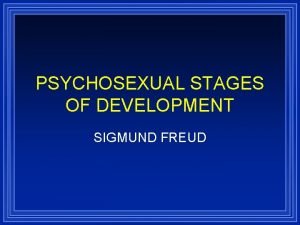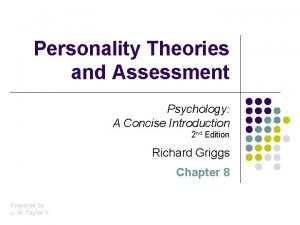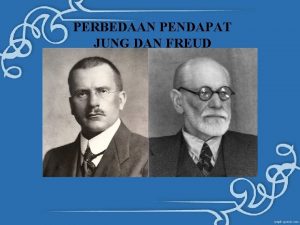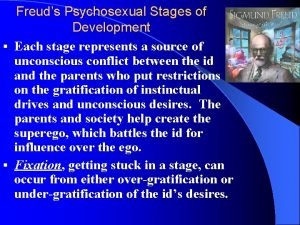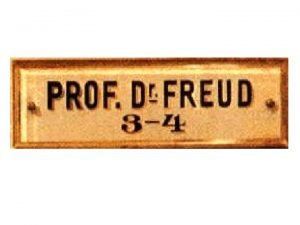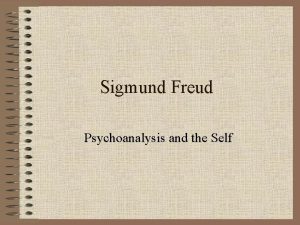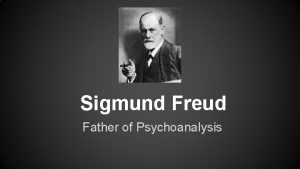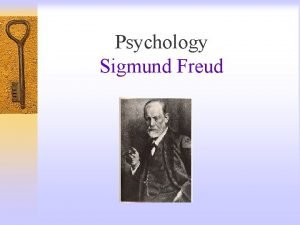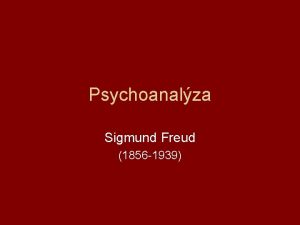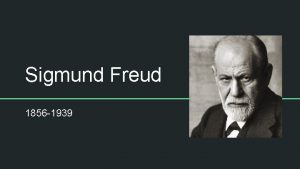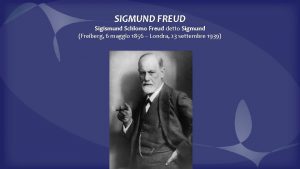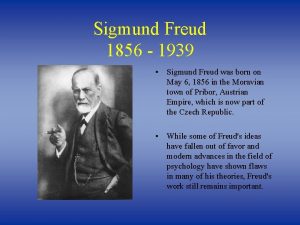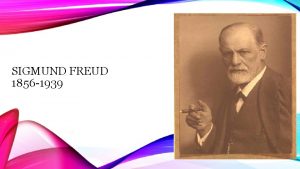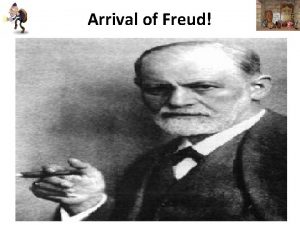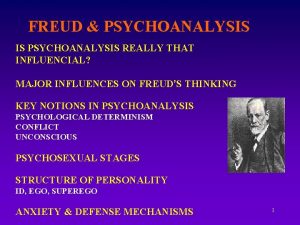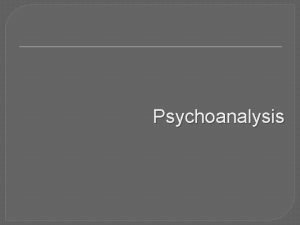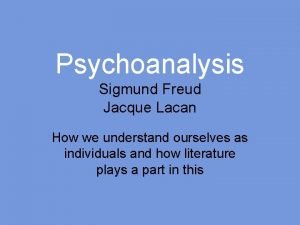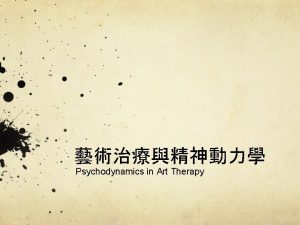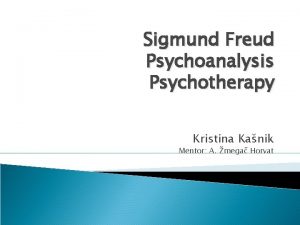Psychoanalysis Sigmund Freud Chapter 2 The Case of






















- Slides: 22

Psychoanalysis Sigmund Freud Chapter 2

The Case of Judy 47 -year-old divorced Caucasian female Complains of symptoms of depression Relevant history Mother left home at age 10 History of physical and sexual abuse Married and divorced twice Attempted suicide three times

Basic Philosophy Pessimistic view of human nature Dominant force is the innate sexual instinct Emphasis on unconscious drives

Human Motivation Primary motivation for humans: Unconscious motives Conflicts between genetically built-in drives Instincts of self-preservation Sex Destruction

Central Constructs Instinct Theory Types of Instincts Life Instinct Eros Death Instinct Thanatos Ways to express instincts Satisfying the need Turning the need into the opposite Turning back on the person Repression Sublimation

Central Constructs Topographic Model Conscious Thought Unconscious Thought Preconscious Thought

Central Constructs The Structural Model Id Ego Superego

Central Constructs Repression Pushing “unacceptable” material to the unconscious…and keeping it there! Always involved in the formation of symptoms Can lead to a person becoming stuck or “fixated” at a particular psychosocial stage

Central Constructs Symptoms as Symbols Symptoms represent: Psychic conflict Unacceptable sexual impulses Symptoms serve as a defense against “unacceptable wishes”

Central Constructs Defense Mechanisms Identification Displacement Projection Reaction Formation Sublimation Regression

Theory of the Person Key Developmental Stages Stage Age Erotogenic Zone Behavior due to Fixation Oral Birth – 1 st year Mouth Nail biting, smoking, overeating Anal 1 – 4 years Anus Anal retentive Anal expulsive Phallic 4 – 6 years Genitals Repression Latent 8 years to puberty Genitals Over-investment in foreplay

Psychological Health and Dysfunction Healthy Personality Able to love and work Demonstrates minimal levels of repression Able to bring unconscious conflicts to the conscious and see them as sources of current behavior

Psychological Health and Dysfunctional Personality Unresolved unconscious conflicts Due to unsuccessful resolution of 1 or more psychosexual stages

Psychological Health and Dysfunction Realistic Anxiety An appropriate affective reaction to real danger Neurotic Anxiety Fear that libidinal drives will be expressed and danger could result Moral Anxiety Fear of punishment by the superego

Psychological Health and Dysfunction Types of Dysfunction Hysteria (Conversion Disorder) Phobias Depression Psychoses

Nature of Therapy Assessment Formal Assessment is used to gather information about the nature of the client’s defenses and unconscious conflicts Clients project their unconscious material onto an ambiguous stimuli

Nature of Therapy Role of the client Reveals everything that comes to mind Role of the counselor Decides what is “real” vs. “not real” Correctly interpret the client’s unconscious material

Nature of Therapy Goals of Therapy Help client uncover and resolve unconscious conflicts Strengthen the ego Psychoanalytic Constructs Insight Resistance Transference Countertransference

Process of Therapy Opening Phase Development of Transference Working Through Resolution of Transference

Therapeutic Techniques Free Association Interpretation Analysis of the resistance Dream analysis Analysis of the transference

Evaluation Qualities Precise/Testable Empirically valid Stimulating Research Support Outcome research Theory-testing research

Issues of Individual and Cultural Diversity Pros Cons Modern offshoots appear to devalue women less Focus of change is on the individual, not the environment Females are HIGHLY motivated by penis envy Clearly rooted in European values
 Freud’s psychoanalytic theory of personality
Freud’s psychoanalytic theory of personality Sigmund freud barn
Sigmund freud barn What are freud's defense mechanisms
What are freud's defense mechanisms Sigmund freud psychodynamic theory
Sigmund freud psychodynamic theory Psychosexual fixation
Psychosexual fixation Regression defense mechanism example
Regression defense mechanism example Personalidad según sigmund freud
Personalidad según sigmund freud Phallic stage
Phallic stage Freud conclusion
Freud conclusion Josef breur
Josef breur The interpretation of dreams 1900
The interpretation of dreams 1900 Sigmund freud id and ego
Sigmund freud id and ego Creative writers and day-dreaming
Creative writers and day-dreaming Chimney sweeping freud
Chimney sweeping freud Sigmund freud ledovec
Sigmund freud ledovec Oedipus complex which stage
Oedipus complex which stage Sigmund freud personality theory
Sigmund freud personality theory Perbedaan teori kepribadian freud dan jung
Perbedaan teori kepribadian freud dan jung Psychoanalytic theory defense mechanisms
Psychoanalytic theory defense mechanisms Phallic stage
Phallic stage Fixation of anal stage
Fixation of anal stage Dr sigmund freud
Dr sigmund freud Freud's theory
Freud's theory
